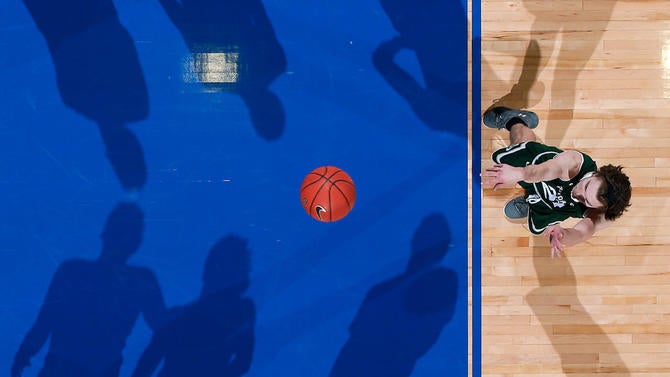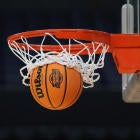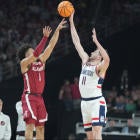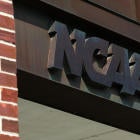The NCAA and CBS will team up again for the third year in a row Saturday to do an in-season reveal of the top 16 teams in college basketball according to the tournament selection committee. The Bracket Preview Show will air at 12:30 p.m. ET, prior to Kentucky-Mississippi State starting at 1 p.m. ET on CBS.
In advance of this, I spoke with the chair of this year's committee, Stanford athletic director Bernard Muir, on Tuesday night and interviewed him about the NET rankings, how they've taken hold, his thoughts on the new process and whether or not the NCAA plans on revealing more about how the NET is compiled. The interview below has been slightly edited for clarity and compendiousness.
CBS Sports: This is your fifth and final season serving on the committee. Broadly, be it because of the NET or any other factors, what has made this season different for you up to now?
Bernard Muir: I think the main thing for me is now to sit in the chair role. Now I'm going to be the one to try and explain the nuances of our process. You're even more locked in and more attentive. The other thing is we have three new members coming on the committee (Atlantic 10 commissioner Bernadette McGlade, Toledo AD Mike O'Brien, Bradley AD Chris Reynolds), so we're trying to make sure we use this time wisely and this is what we call our new member orientation, so they will get a chance to ask questions -- and we get a chance to provide advice as to how they're looking at things.
CBS Sports:The committee convened officially starting Tuesday and will through end of week. What is happening this week that college basketball fans should be aware of?
Muir: (Tuesday) was more of a chance for us to get our shop in order and get a feel of what exactly what we're going to experience in selection week and what the timeline looks like, how we might go about our work. We also took today, a good few hours, talking about our conference monitoring. Each committee member has a number of conferences that they're talking to throughout a season. This allows for committee members to report out what they heard, their own assessment about various schools in all of the 32 conferences and where they see them. We get to chime in and ask questions.
We'll do it again on a call prior to selection week and once we get to the first day of selection week we'll do it again to see what has changed. We ended (Tuesday) with an initial ballot and we will know the full results of that ballot (Wednesday) morning and then will get into the seeding process, and our goal is to seed 24 spots on the list and then from that be able to bracket our 16 to announce on Saturday.
CBS Sports: Washington is 18-4 but still not ranked. Part of that can clearly be attributed to its Pac-12 affiliation and how poorly the league was in nonconference play. Can you explain to college basketball fans how those biases, which have crept into the voting among AP pollsters, are dodged in the committee room?
Muir: I would say the polls are just one tool that we have at our disposal. We're going to look obviously at the new metrics now. We have other metrics that we review. So when you're talking about schools like you just talked about, we have to listen as a 10-member committee and talk about the strengths and weaknesses of teams vs. others we have under consideration at the time in their pool [of similar teams]. To say how they might fare based on a poll, it's not really doing the conversation justice because there's going to be so much more work and discussion and thoughts that go into where a team falls.
CBS Sports: "Sorting tool" might well become the buzz phrase of 2019 with you and the committee. Is it a priority of yours to hammer home the notion that the NET rankings don't dictate how teams are viewed in terms of their seeding and selection potential?
Muir: I would say you're right that it is a sorting tool. We will use it in all facets of our work in selection and seeding, but at the same token, each committee member has the opportunity to weight different things. I should also underscore observation is going to be really critical. The one thing you don't find from the NET or some of these other rankings is, OK, what happens when a student-athlete goes out because of injury? And how did they play when they came back immediately? That's why we use the term "sorting tool," but it does help that it provides an idea of here's some quality wins, quality losses and a lot in between.
That's why the quadrants are helpful. We recognize now, even more so than prior, road wins and crediting road wins. That's something we heard from our coaching brethren, the National Association of Basketball Coaches saying, "We want this factored in as you continue to compare teams and trying to select and seed."
CBS Sports: Coaches have spoken about their awareness of scoring margin with the NET. Buzz Williams most recently on Monday night. Are they misguided in thinking that winning or losing a game by seven or eight points vs. 11 or 12 points makes any real difference in how their team lands in the NET and can affect seeding or selection?
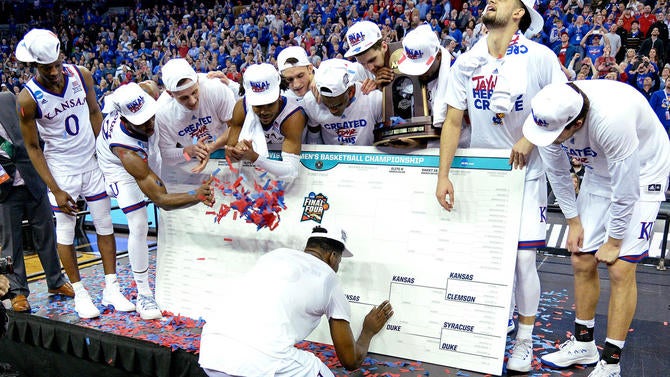
Muir: Since there's a lot of machine learning and nuances to the metrics I should leave up to the experts, what I would say is — based on your question — I'd be heard-pressed to think whether you win by 11 or you win by eight, whether that makes a big difference in our process. What we're going to now acknowledge is the team who's won the game, the team that lost the game, where that game was played and what happened in that game. That's what's most important.
There's thousands of possessions during the course of a season, and so to just boil down to one possession as to where you're going to be on the seed line or whether you're going to be selected or not, I think you're looking at something miniscule. It's much broader than that. If a really good team wins at another place and played well and won by 20, well we take note of that. Does it make a difference if it's 20 or 18? Probably not.
CBS Sports: Do you put as much philosophical stock into KenPom, KPI, BPI and the like as you do the NET, or do you knowingly put more emphasis on the NET's numbers given that they are the ones determining strength of schedule, etc. on the team sheets?
Muir: This is going to sound politically correct, but I'm looking at all of it. To say I weight one over the other, it would be really difficult. I'm trying to be consistent in how I look at it. I think all of the tools are really important just to get a snapshot of a particular team. I think observation is really critical too. I think schools would expect our group, our 10, to put great stock into, hey, what did you see? That's collectively where 10 members are really helpful to say, how did you see this, how did factor that in, here's what some of the metrics say. To say I'm just going to use these tools or a particular tool, there's so much more that goes into a particular account when you're making your selections.
Getting feedback from the conferences is also helpful. They're providing us how they see their league and then we're trying to combine all 32 to say "OK, how does this all come together?"
CBS Sports: Speaking of conferences, teams are not judged by the conference they come from, and yet, I have to note that the MAC and SoCon rank in the top 10 at KenPom.com among all conferences, ahead of the A-10 and Mountain West. Is it fair to speculate that teams such as Wofford, Buffalo, Liberty, Lipscomb, Belmont and perhaps a few others are benefitting from a healthy NET rating and therefore stand to have a better chance at being more doggedly debated come March if they continue to perform similarly to how they have to this point?
Muir: I think my answer to that question is, the teams you reeled off are teams that went out played competition, won games, played them close, didn't have as many bad losses and so their rankings are elevated. And I think that's for any team, whether that's the mid-major or major school and maybe you get few more opportunities. But the teams you're talking about, every year we have teams like that we really have to discuss and evaluate because they've done something notable in their schedules and that is going to draw interest of the committee.
CBS Sports: What did you make of the initial criticism of the NET rankings in late November?
Muir: I thought, like may of our committee members, it was just way too early. Under the old RPI if you had pulled it up early as it was released, you'd get some teams that you'd scratch you head and say, well how did they get there? And as more games were played, things started to settle in. You started to see these teams started to make sense why they're up at the top. We're crediting what teams do and when they can win on a neutral side or on the road, they get credit for that and I think that's a heck of a component that we've added, as well as some of the efficiency numbers. The one thing the NABC suggested is to put in some of the predictive metrics as well too as part this overall evaluation.
CBS Sports: I'm sure you're aware of the fact that there are some elements repeating in the formula of the NET, particularly with margin of victory capped at 10 but raw efficiency margin is uncapped. Do those potential mathematical issues bother you? Where do you stand with that?
Muir: I stand with we need, as a committee, to talk further about those issues. We're aware of them; coaches have brought them up. Hopefully we're talking about small differences here, but it's going to require further discussion. As I said, We want to be as accurate as we can and we'll have to see where that leads us. But we're very pleased with the initial findings of the NET. Could there be additional things to come? There may be and there may not be. I'm not quite certain. But we need further discussion along with our experts to find out how valid are these concerns.
CBS Sports: Are there any plans to make the NET's formula specifics transparent by end of season?
Muir: I think what we've provided in terms of the overall formula — not knowing the inner workings, because of some of it, I just don't know how'd you'd explain with the machine-learning component tied into it. I think for now what we've [published] is what we're going to have. But certainly as a committee we'll continue to talk about how we can provide additional information that's easily understandable for the broader public.
(Ed. Muir noted that he's meeting with a Google analytics team on Wednesday morning to learn more about the tool, and that no tweaks are expected to be made this season with the NET.)
CBS Sports: Some of the big conferences have bloated their league schedules to 20 games. There are concerns from coaches in smaller leagues that this is squeezing out their already-limited opportunities to schedule top 75-type competition in November and December. You're the AD at Stanford. The Pac-12 sits at 18 league games and has debated going to 20. Is it in the best interest of men's basketball that leagues go to 20-game schedules?
Muir: I still think there's opportunities, as you just mentioned with the NET, like some of the schools you'd label mid-major, they're making the most of their opportunities and playing quality games. I'd like to think that, because the NET — we were chatting about this as a committee — there's still some great games that we're seeing in Quadrant 1 where we might not have seen that under the old system.
What I would say to anybody at any level, boy there's still some quality games to be had. And if you can go out, especially on the road and win those games games, that's going to draw the attention of this group. If you look at some of the teams that appear in Quadrant 1 and Quadrant 2, you can pick up some great games, especially if you win them, that will raise your overall NET score.
CBS Sports: Let's say you've got a good team from a mid-major league that goes 1-4 in Quad 1 and 2 opportunities, but all four of those losses happen to be all extremely close. Is it your belief that if you play close and have a limited amount of opportunities, that doesn't necessarily kill off a small team's chances?
Muir: The key would be, OK, who are those close games against? If it's teams in Quad 4, that might hurt even more so. If you're talking about Quad 2 and don't have many in Quad 1, something to discuss with the committee is we understand there's some good teams that just didn't get as many great opportunities in Quad 1 as you might have thought. And when they scheduled, some of those teams traditionally might have been Quad 1 but they moved back. We'll note that in the discussion too.
CBS Sports: The selection and seeding process has evolved, mostly for the better, in the past decade. But as chair now, what area do you think still could use the most tweaking or upgrading?
Muir: I would say I'm happy with our process. With how this NET plays out, what we glean from it this year will be interesting. It's been helpful the past couple of years as we've introduced predictive metrics in our discussion. More so I think that's been a good thing for us especially in terms of seeding and getting that seeding right because that's so important to creating a balanced bracket and a great national tournament. I'm not sure exactly what is to come, but I'm sure in the next two, three, four years we'll have tweaking along the way to make it even better.
NET vs. RPI: which teams most helped, hurt in new system
In terms of game tonnage, college basketball's season is about 70 percent complete. (Yes, it is flying by.) With so much data in, I thought it time to check in on the NET rankings and see where the biggest discrepancies are between top-50 NET teams and noisy contradictions in the obsolete RPI. The NCAA officially removed its affiliation with the RPI last offseason, but let's consider how some teams' tourney chances and/or seeding would be viewed if the NET didn't exist. (I just got chills.)
Helped by the NET
- NC State: 86 spots higher (121 in RPI, 35 in NET)
- Nebraska: 71 spots higher (104 in RPI, 33 in NET)
- Liberty: 73 spots higher (127 in RPI, 54 in NET)
- Florida: 38 spots higher (80 in RPI, 42 in NET)
- Saint Mary's: 25 spots higher (71 in RPI, 46 in NET)
- Lipscomb: 24 spots higher (56 in RPI, 32 in NET)
- Virginia Tech: 19 (29 in RPI, 10 in NET)
- Baylor: 18 (49 in RPI, 31 in NET)
Frankly, if the NET wasn't around, NC State (16-7) and Nebraska (13-9) would not be thought of as reasonable NCAA Tournament teams. The Wolfpack's case was hurt furthermore by losing at UNC on Tuesday night. In a span of two games, NC State scored only 24 and allowed 113. It's also encouraging to see mids like Liberty and Lipscomb getting very important boosts from the NET here. Saint Mary's ironically schedules tougher than in most seasons, but its 14-9 record is very much hurting its case.
Hurt by the NET
- VCU: 21 spots lower (28 in RPI, 49 in NET)
- Kansas State: 17 spots lower (13 in RPI, 30 in NET)
- Kansas: 16 spots lower (1 in RPI, 17 in NET)
- TCU: 14 spots lower (23 in RPI, 37 in NET)
- Belmont: 15 spots lower (48 in RPI, 63 in NET)
- Oklahoma: 13 spots (25 in RPI, 38 in NET)
The Big 12 gets dinged plenty in this NET-conscious environment, interestingly enough. I wonder if Kansas' No. 1 seed outlook would be more generous in an RPI-aware world. Will also note that Belmont is the only mid-major of note that is really affected negatively in NET vs. RPI as of now. Rick Byrd will not stand for this!
We're still parsing out the patterns and learning about how much weight is truly put on efficiency margin, road performance, opponent quality, etc. Though the NCAA's going to hammer home "sorting tool" with NET, I'm relatively optimistic at seeding and selection for deserving mid-majors given early returns.
Furman chasing bid thanks to best all-around mid-major player
Furman became the mid-major darling of the early part of the season when it went up to Villanova and stunned the Wildcats. The Paladins opened the season 12-0, are 18-5 now and still have a respectable NCAA Tournament dossier in what's a competitive Southern Conference.
While Jordan Lyons made headlines earlier this season by sinking 15 3-pointers in a game, senior Matt Rafferty is the name to know. Rafferty is who came up big late to beat Nova. He's an efficiency monster and probably the best all-around player in mid-major college hoops. According to Sports Reference - College Basketball, Rafferty's averages of 17.0 points, 9.1 rebounds, 4.3 assists and 2.7 steals shouldn't be sustainable. No player has ever finished a season averaging 17/9/4/2 in the history of College Basketball Reference's database. His 2-point percentage is 65.6 and he's leading the SoCon with 3.5 steals per game.
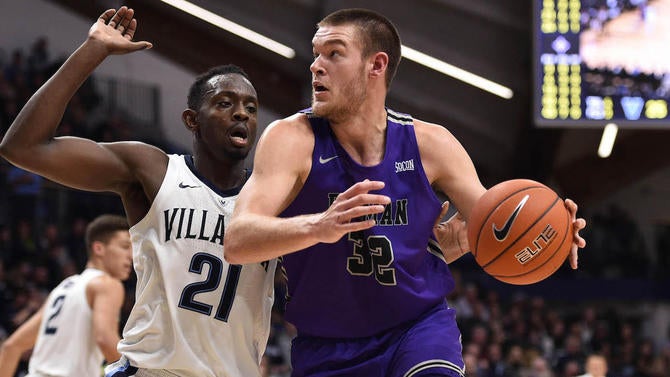
"I would put him up against anyone in the country, even modern-day basketball, in that he gets more out of his God-given ability than any player," Furman coach Bob Richey told me. "You're not talking about somebody that's overly athletic. He's obsessed with winning to a point where he just doesn't care about anything other than that."
Rafferty is the winningest player in school history, having been a part of 83 victories and counting. At 6-foot-8, he's a former high school quarterback who has become one of the best big-man passers in college basketball. He's also reportedly exceeding tough, so much to the point where in a game last season Richey said Rafferty's jaw became dislodged and he walked over the bench, popped it back into place himself then promptly returned to action.
Richey said his craftiness is amazing to watch because he's not even prone to dunk in a game. And what's more, Richey estimates Rafferty's won about 85 percent of jump balls this season.
"It's almost a joke on our bench, 'He's going to win this jump ball,'" Richey said, adding, "he's freaking leading the SoCon in steals right now, a five-man. The guy is a ball player, full definition."
Rafferty's also the only player top-five in offensive and defensive win shares (his 6.1 win shares is No. 1 in college basketball). He's been a humble four-year starter, but only now is he making the Lou Henson Award Watch List; the award goes to the top mid-major player in the country. If Furman can break into the NCAAs this season, Rafferty going up against a power-conference big might be an unfair fight -- for the other guy.
Buzzer beaters
- Indiana coach Archie Miller told me on Tuesday that Hoosiers senior Juwan Morgan -- who left IU's game vs. Michigan State on Saturday with a shoulder problem -- is "fine," feeling better and able to practice. Morgan has a history of shoulder problems, which is concerning, but if he can avoid any lingering pain, he should be back in the lineup soon.
- I'll be in Charlottesville, Virginia this Saturday for the game of the weekend: No. 2 Duke at No. 3 Virginia. The injury news of note is in regard to UVA point guard Ty Jerome, who is recovering from a back issue sustained in UVA's win at NC State on Jan. 29. Virginia coach Tony Bennett is hopeful but non-committal at this point about Jerome's availability for the weekend. Remember, Duke point guard Tre Jones did not play in the Blue Devils home win over Virginia on Jan. 19.
- Fouling frequently is not a way to winning often. Consider: There isn't a team in the top 70 in total fouls this season that projects as an NCAA Tournament at-large candidate. The most foul-prone major-conference team that was in Jerry Palm's latest bracket? North Carolina State. The Wolfpack have 437 hacks this season (19.9 per game). Beware picking them in March -- if they get a dance ticket.
- College basketball had the rare quadruple-double occurrence over the weekend. Congratulations to Grambling's Shakyla Hill, who now claims TWO quadruple-doubles, the only player in NCAA history to achieve the feat.
- On Super Bowl Sunday, Darren Rovell tweeted about championship-game variety in pro sports over the past 20 years. College hoops has a better spread than you might have assumed: 22 out of a possible 40 schools have played in the title game the past 20 seasons. They are: UConn, Duke, Michigan State, Florida, Arizona, Maryland, Indiana, Syracuse, Kansas, Georgia Tech, UNC, Illinois, UCLA, Ohio State, Memphis, Butler, Kentucky, Louisville, Michigan, Wisconsin, Villanova, Gonzaga.
- The Atlantic 10 announced Tuesday that its conference tournament has agreed to play in Washington, D.C. in 2022, then will be back in Brooklyn in 2023 and 2024. That's a big coup for the A-10 and also an indication that the ACC and Big Ten will not be pushing for frequent NYC-area appearances for their league tourneys. (Last December, the Big East announced its deal with MSG for its league tournament was locked up through 2028.)
Can't help but chuckle at this. Minnesota coach Richard Pitino is trying to do his job ... but his kid has to pee. And his kid doesn't much care about the game going on.
Hey!!! When you gotta go, you gotta go!!!! Even if your Dad is in the middle of a battle with @BoilerBall #BoilerUp pic.twitter.com/6PVCf89r01
— Dave Marren (@DaveMarren) February 4, 2019
Final shot
Colorado State's Logan Ryan shoots through the shadows of Clune Arena against Air Force over the weekend. Pic via Isaiah J. Downing of USA Today Sports Images.
